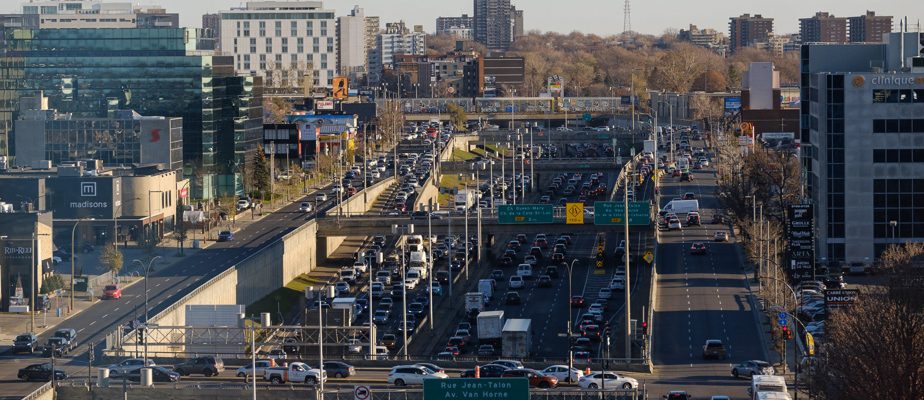Greenhouse gas (GHG) emissions from the island of Montreal continued to rise in 2019, show the most recent inventories of the metropolis, as the second Montreal Climate Summit opens.
What there is to know
The island of Montreal’s GHG emissions have been increasing since 2016, with the exception of the pandemic year of 2020.
The metropolis is thus moving away from its 55% reduction target by 2030.
Announcements “to accelerate climate action” are expected at the Montreal Climate Summit, which is being held this Tuesday and Wednesday.
The Montréal agglomeration, made up of the 15 cities on the island, thus generated 12,108 kilotonnes (12.1 million tonnes) of GHGs in 2019, an increase of 3% compared to the previous year.
Emissions then declined to 10,120 kilotonnes in 2020, the first year of the COVID-19 pandemic, which is however “considered not representative of the effects of reduction efforts” due to the economic downturn and lockdowns, the report says. two inventories unveiled simultaneously.
The document, which was released recently without fanfare, is dated April 17, 2023.

Drops erased
By increasing its emissions from 2016 to 2019, the Montréal agglomeration has thus erased its previous declines at a sustained pace.
In 2016, the reduction in emissions in the metropolis reached 28% compared to their 1990 level, but in 2019, this reduction was only 20%.
Montreal’s reduction target is 55% by 2030 compared to 1990 levels.
“The challenge is great,” summarizes the holder of the Research Chair in Decarbonization at the University of Quebec in Montreal, Mark Purdon. “There is a long way to go. »
In particular, he points the finger at transport, the increase in emissions of which was 18% in 2019 compared to 1990.
“It’s a challenge because it’s not just the City of Montreal that controls emissions in that sector,” he notes, referring to the surrounding municipalities, but also the other levels of government.
And it’s not enough to add public transit, we also need to densify cities to reduce transportation needs, but “it’s not something we can easily do by 2030,” he warns. .
Without land redevelopment, [le transport en commun] will not lead to a rapid decrease in GHG emissions.
Mark Purdon, holder of the Research Chair in Decarbonization at UQAM
Emissions from stationary sources, which represent the other major emission sector with transportation in Montreal, decreased by 37% in 2019 compared to 1990, but have increased slightly since 2016.
“Hope in the stationary source sector is heat pumps,” which are still little used in Quebec, says Mr. Purdon.
Known solutions
The reduction effort “which was already enormous [est maintenant] even bigger”, recognizes Sidney Ribaux, director of the office of ecological transition and resilience of the City of Montreal.
The metropolitan climate plan, adopted in 2020, was prepared with data from 2015, he says. “It is clear that the starting point is higher [maintenant]. »
In the transport and stationary emission sources sectors, “it will be extremely difficult to achieve the targets, but we know the solutions and we will be able to implement them”, maintains Sidney Ribaux.
The situation will be more complicated in other sectors, such as industry, he said. “This is where we will need both technical and regulatory innovation. »
A plan to improve
With only a third of the reduction target achieved and emissions on the rise, future measures must “be tough, fast and structuring”, particularly in the transportation sector, warns Andréanne Brazeau, climate policy analyst at Équiterre.
Our car fleet is growing three times faster than the population. In Quebec, our vehicles are larger, more numerous and travel greater distances, so all the gains we have made in energy efficiency and electrification are cancelled.
Andréanne Brazeau, analyst at Équiterre
The city’s climate plan will have to be greatly improved, says Patrick Bonin, head of the climate-energy campaign at Greenpeace Canada.
“If we have one of the most determined actors who is not on track to achieve his objective, it is not the provincial and federal governments, whose climate leadership is even more questionable, who will reassure us,” says- he.
Especially since 2021 emissions promise to start rising again, as evidenced by the 2021 federal inventory, published in April, which showed a 1.8% increase nationwide.
“It is sure that it will increase, the question is how much”, indicates Sidney Ribaux.
New measures to fight climate change must also be announced at the Montreal Climate Summit, which is being held this Tuesday and Wednesday at the Grand Quay of the Port of Montreal.
Data over two years old
The inventory of greenhouse gas emissions for the Montréal agglomeration presents data that is more than 27 months old. This delay, which is attributable to “the complexity and the choice of data sources”, will be reduced to 18 months due to a “significant restructuring” of the inventory process and the calculation methodology, indicates the City. The 2021 emissions inventory should therefore be published during the summer. At the federal level, the inventories are published with a delay of fifteen months: that of 2021 was published in April. In Quebec, the delay is nearly 24 months: the 2021 inventory will be published next December.
Learn more
-
- 13.5%
- Proportion of Quebec’s greenhouse gas emissions from the Island of Montreal
sources: City of Montreal and Ministry of the Environment and the Fight against Climate Change, Wildlife and Parks of Quebec
